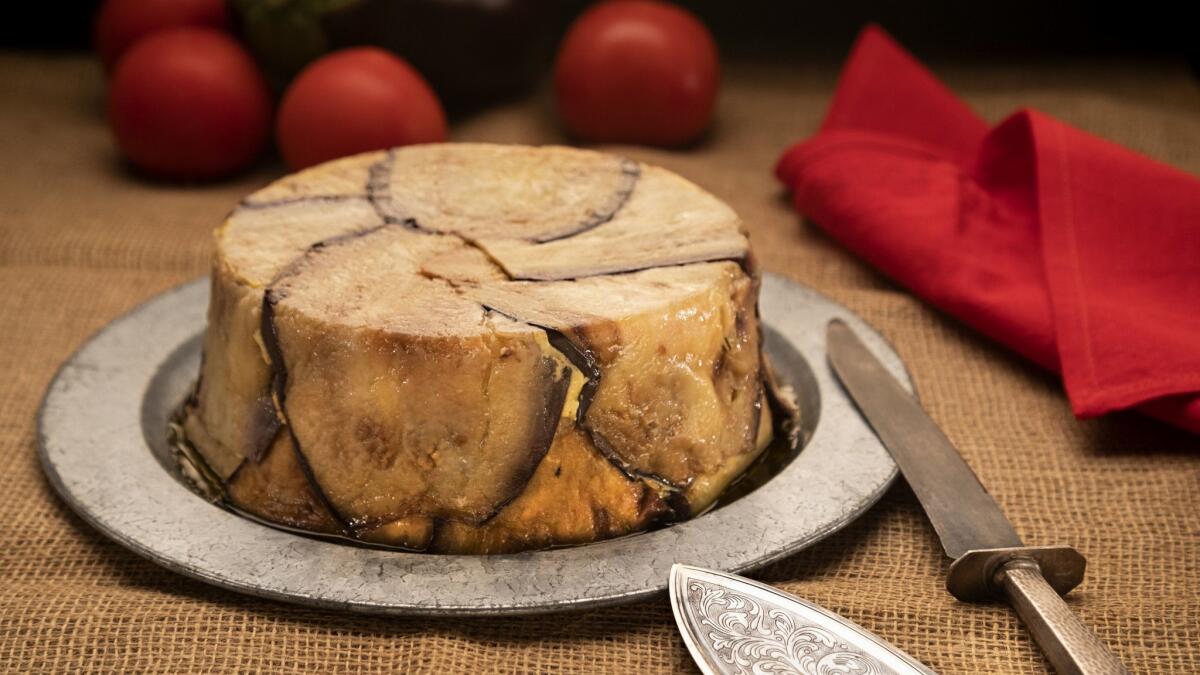Cucina Italiana: The joy of eggplant. Try making a <i>timbale</i>

I’ve had two eggplant epiphanies in my life. The first was in the Sicilian town of Taormina in the late 1970s, when I was introduced to the prodigious variety of eggplant dishes. The second was in my Angeli restaurant kitchen a decade later cooking my first farmers market eggplant.
Before either of these experiences, my acquaintanceship with eggplant was limited to tiny cans of Progresso caponata, whose ebullient, colorful exterior hinted at the flavor within. For some reason caponata, the luxurious olive and caper studded appetizer of fried eggplant, was a ubiquitous accompaniment to Scotch and soda in Silver Lake in the 1960s. The can was handed to me by my mother with a fork and a nudge of her head indicating the location of the can opener. I did what was required and was rewarded by a strange mélange of tender, oily cubes that were slightly sweet, slightly sour. How mom got me to eat the unattractively colored stuff at the age of 9 is a mystery. But the texture hooked me, as did the understanding at that young age that eggplant was a kind of sponge, able to soak up an outsize amount of flavor. The other appearance of eggplant in my childhood was eggplant Parmesan, which tended to be a leaden affair of heavily breaded eggplant layered with copious amounts of mozzarella and overly cooked tomato sauce.
My first trip to Sicily in the ’70s involved dinner at a place called La Botte. The ubiquitous welcoming antipasti table (pre-Euro zone health department rules) was laden with a dozen dishes all containing eggplant. Who knew there could be such variety? There were at least two types of caponata, various dishes of grilled slices, some rolled with filling; eggplant sott’olio, preserved in oil; and in the center a simple yet striking eggplant cake-like thing that I later learned was a timbale.

I came back from that trip, opened my paperback copy of Elizabeth David’s “Italian Food” (catchy title, that) and dug into the eggplant recipes — in particular, her melanzane alla Parmigiana. David was the British food writer of the mid-20th century and is often credited with reviving British home cooking after the war. Her recipes were very direct, just a few sentences long, but the results were the kind of opulence in frugal Mediterranean simplicity that we take for granted now. Reading her recipe brought me back to that Sicilian antipasto and the timbale. The flesh of the vegetable was luxuriously tender with oil, yet not greasy. There was just enough cheese to add its satisfying umami without being heavy, and the tomato sauce, quickly cooked, was the perfect sweet-acid component to balance the fried eggplant slices.
Which brings me to that farmers market eggplant or my epiphany about freshness and quality. There are some vegetables — fruits to be exact, tomatoes for example — you assume will be of astoundingly different quality bought at a farmers market, but an eggplant? I’m ashamed to admit how long it took me to actually buy one of those lavender-streaked white beauties called Rosa Bianca. The difference in texture is huge. Freshness will translate to light tenderness when a farmers market eggplant is properly salted and cooked. The texture will be creamy and the flavor sweet, with no hint of leathery bitterness that so many find off-putting in eggplant. And it cooks up faster than supermarket eggplant that’s been too long in the bin, perhaps because of the more abundant water still held within the fruit. I love how when you grill eggplant you can actually see the water boil inside the slices. For freshness cook eggplant in season and look for dense fruit with smooth, shiny skins.
Avoiding old, bitter eggplant leads us to a discussion about salting. The reason one salts eggplant is to remove “bitter juices.” Truthfully, maybe it’s because I live in California, but I’ve only come across a couple of bitter eggplants in my life. Both times they were supermarket eggplants bought out of season and full of little black seeds. Eggplant, like all nightshade fruits/vegetables, is a summer player. But learning how to salt eggplant makes sense for those times you’re dealing with less than stellar produce. Fresh eggplant stays fluffy if not salted. Salting also makes the flesh denser, meatier once cooked. I prefer fluffy, so if I have a very fresh, pretty eggplant, I don’t bother.
This timbale is my salute to David. Each time I make it I wonder why I don’t make it more often.
For this dish you will cut the eggplant into long slices. You can either peel the eggplant or leave the peel on for color contrast. Put a double layer of paper towel on your counter top, then lay out the slices. Salt the slices. It will take about 2 to 3 tablespoons to salt one large eggplant. Leave the eggplant alone to purge the excess water. In about half an hour you will see beads of moisture on the surface of the slices. I prefer to let the salt do its job for about an hour. Rinse off the salt under cold water and blot the slices dry with a kitchen or paper towel. You are now ready to make the recipe.
Why bother to make the timbale instead of traditional layered eggplant Parmesan? Because it’s unexpected, fun to make and will make those you share it with feel special.
More to Read
Eat your way across L.A.
Get our weekly Tasting Notes newsletter for reviews, news and more.
You may occasionally receive promotional content from the Los Angeles Times.






